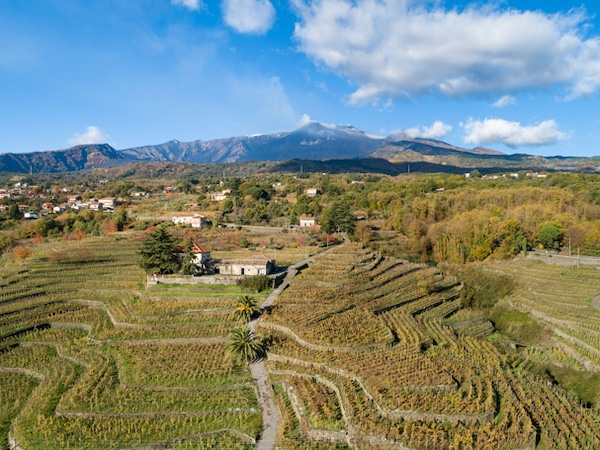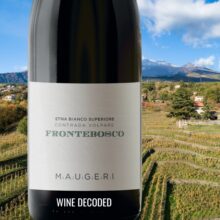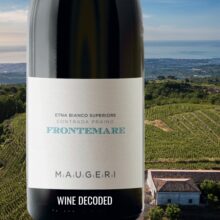
Winery
Maugeri
The styles of Etna Bianco are as diverse as the vineyards!
The Maugeri family have returned to their home district to make wine once more. Dad Renato and his daughters Carla, Michela and Paola work with the very talented consulting enologist Emiliano Falsini (who collaborates with some of my favorite Sicilian and Tuscan wineries). The vineyards are visually dramatic, with 83 terraces, stretching between Contrada Praino and Contrada Volpare, through the pathways of the Milo forest, 700 m above sea level, on the eastern slopes of Mount Etna. The vines, planted with chestnut wood posts, cover 7 hectares in an amphitheatre of fertile volcanic soil, in a close embrace with the Mediterranean landscape. If you were to line up those lave stone walls, they would measure 2.8 kilometers in length.
Carla Maugeri is an architect, and her aesthetic choices can be seen in the clean label designs and marketing of the family wines. However, if you visit Etna, I absolutely recommend that you book your stay at the Maugeri family’s boutique hotel nestled within an enormous orange grove. Zash offers gorgeous accommodation with a Michelin-starred restaurant run by chef Giuseppe Raciti.
In the Vineyard
Etna, the volcano: energy that is renewed.
Viticulture on Etna is a challenge and a gift at the same time. The very particular microclimate of the area and the fertility of the volcanic soil offer the vine an ideal setting and give the grapes unique characteristics. Thus the link between the wines of the Maugeri Winery and the land of Etna flows in the vineyard and is sublimated in the bottle.
VINEYARD FACING THE SEA
The breezes blowing in from the Ionian Sea help the grapes flourish, keeping them healthy, dry and fresh. In summer, the leaves dance with a continuous, delicate movement, visible from the shade of century-old palm trees.
Sea breezes also benefit the dense natural undergrowth, promoting the wealth of native biodiversity beneath the vines. The turquoise line of the sea borders this vineyard and dominates the view.
VINEYARD FACING THE VOLCANO
The vineyard looking onto Mount Etna is the highest part of our Estate. The volcano makes its presence felt here with a white cloud hanging above the summit: sometimes snow, sometimes smoke.
On the one side is the oak wood, on the other the outline of the craters, where in the mornings, the first signs of life from the volcano appear.
In the Winery
Milo is the only area permitted for wines labeled Etna Bianco Superiore, according to the Etna D.O.C. rules.
Native varieties, with no modifications, making a positive choice to respond to the call of this piece of land, for the “white”. This is, in brief, the wine-making philosophy of Maugeri.
The local varieties are the stars of the labels: the Carricante (in purity), whose chosen place in the East is recognised by its mark as Etna Bianco Superiore, and the Nerello Mascalese, which produces an elegant rosé and Catarratto a fresh, fragrant white.
For the whites, the grapes are harvested by hands and undergo a process of cryomaceration for a few hours. The must ferments and matures in oak for 6 months. The maturation then continues in stainless steel tanks for 4 months before bottling.
Where in the World is Maugeri?
Maugeri is located in Milo on the eastern slopes of Mount Etna, Sicily, Italy.

